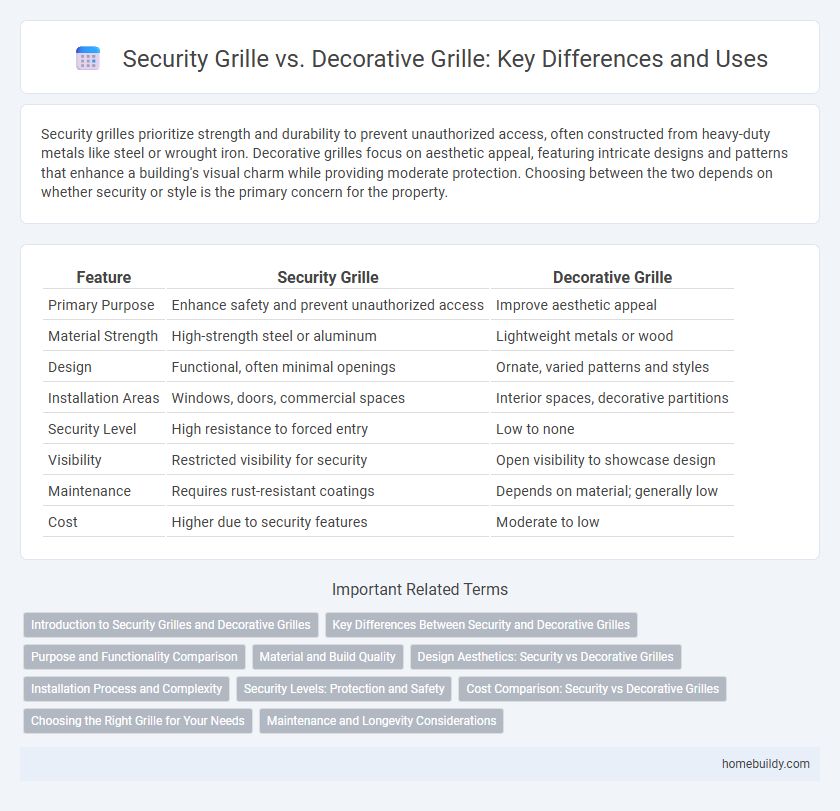Security grilles prioritize strength and durability to prevent unauthorized access, often constructed from heavy-duty metals like steel or wrought iron. Decorative grilles focus on aesthetic appeal, featuring intricate designs and patterns that enhance a building's visual charm while providing moderate protection. Choosing between the two depends on whether security or style is the primary concern for the property.
Table of Comparison
| Feature | Security Grille | Decorative Grille |
|---|---|---|
| Primary Purpose | Enhance safety and prevent unauthorized access | Improve aesthetic appeal |
| Material Strength | High-strength steel or aluminum | Lightweight metals or wood |
| Design | Functional, often minimal openings | Ornate, varied patterns and styles |
| Installation Areas | Windows, doors, commercial spaces | Interior spaces, decorative partitions |
| Security Level | High resistance to forced entry | Low to none |
| Visibility | Restricted visibility for security | Open visibility to showcase design |
| Maintenance | Requires rust-resistant coatings | Depends on material; generally low |
| Cost | Higher due to security features | Moderate to low |
Introduction to Security Grilles and Decorative Grilles
Security grilles are designed primarily to enhance property protection by providing a robust barrier against unauthorized access, typically constructed from heavy-duty steel or aluminum. Decorative grilles prioritize aesthetic appeal, often featuring intricate designs and lighter materials to complement architectural styles while offering minimal security. Both types of grilles serve distinct purposes, with security grilles focusing on strength and durability and decorative grilles emphasizing visual enhancement.
Key Differences Between Security and Decorative Grilles
Security grilles are designed with robust materials such as steel or wrought iron to provide maximum protection against intrusions, whereas decorative grilles prioritize aesthetic appeal using lighter, more intricate designs often made from aluminum or wrought iron. The primary function of security grilles is to enhance safety by preventing unauthorized access, while decorative grilles focus on complementing architectural styles and adding visual interest without compromising security. Security grilles typically feature tighter spacing between bars and reinforced locking mechanisms, contrasting with the open patterns and ornamental elements common in decorative grilles.
Purpose and Functionality Comparison
Security grilles are designed primarily to provide robust protection against unauthorized access, featuring heavy-duty materials like steel or iron to enhance durability and resistance to break-ins. Decorative grilles, while offering some level of security, prioritize aesthetic appeal with intricate designs and lighter materials, making them less effective for high-security needs. The core functionality of security grilles revolves around safety and deterrence, whereas decorative grilles balance visual enhancement with basic security.
Material and Build Quality
Security grilles are constructed from heavy-duty materials such as steel or wrought iron to provide robust protection against break-ins, featuring reinforced frames and tamper-resistant fastenings. Decorative grilles prioritize aesthetic appeal, often made from lighter metals or aluminum with intricate designs but lack the structural strength essential for high security. The build quality of security grilles emphasizes durability and resistance to force, ensuring maximum safety, whereas decorative grilles focus on visual enhancement with less emphasis on physical protection.
Design Aesthetics: Security vs Decorative Grilles
Security grilles prioritize robust materials like steel or aluminum, designed to provide maximum protection against intrusions while maintaining visibility and airflow. Decorative grilles emphasize intricate patterns and ornamental designs using lighter materials such as wrought iron or powder-coated metals, enhancing aesthetic appeal without compromising structural integrity. Choosing between security and decorative grilles depends on balancing functional safety needs with desired architectural style and visual impact.
Installation Process and Complexity
Security grilles typically require a more complex installation process due to the need for heavy-duty mounting and secure anchoring to prevent forced entry, often involving drilling into walls and frames. Decorative grilles focus on aesthetic appeal and generally have simpler installation methods, such as surface mounting or being attached with lighter fixtures. The complexity of installing security grilles demands professional expertise to ensure maximum safety and compliance with security standards.
Security Levels: Protection and Safety
Security grilles are engineered with high-strength materials such as steel or aluminum to provide robust protection against forced entry, significantly enhancing safety for residential and commercial properties. Decorative grilles, while aesthetically pleasing and available in various intricate designs, offer minimal resistance to break-ins and are primarily intended for visual appeal rather than security. Choosing a security grille ensures a higher security level by combining physical deterrence with durable construction, whereas decorative grilles focus on enhancing architectural style with limited protective capabilities.
Cost Comparison: Security vs Decorative Grilles
Security grilles generally incur higher initial costs due to robust materials like steel and enhanced locking mechanisms, while decorative grilles tend to be less expensive, using lighter metals or aluminum. Maintenance costs for security grilles may also be greater because of their heavy-duty construction and risk of corrosion if not properly treated. Budget-conscious buyers often weigh these cost differences against the primary need for protection versus aesthetic enhancement when selecting between security and decorative grilles.
Choosing the Right Grille for Your Needs
Security grilles offer robust protection with heavy-duty materials and reinforced designs to deter break-ins, while decorative grilles prioritize aesthetic appeal with intricate patterns and lighter construction. When choosing the right grille for your needs, assess the level of security required alongside design preferences and installation environment. Opt for security grilles in high-risk areas where safety is paramount, and consider decorative grilles to enhance appearances in less vulnerable locations.
Maintenance and Longevity Considerations
Security grilles are designed with robust materials like steel or wrought iron, ensuring enhanced durability and lower maintenance requirements compared to decorative grilles, which often use lighter metals or intricate designs prone to wear. The powder-coated finishes on security grilles resist rust and corrosion, significantly extending their lifespan in harsh environmental conditions. While decorative grilles prioritize aesthetics, security grilles focus on long-term functionality, reducing the need for frequent repairs and upkeep.
Security grille vs Decorative grille Infographic

 homebuildy.com
homebuildy.com